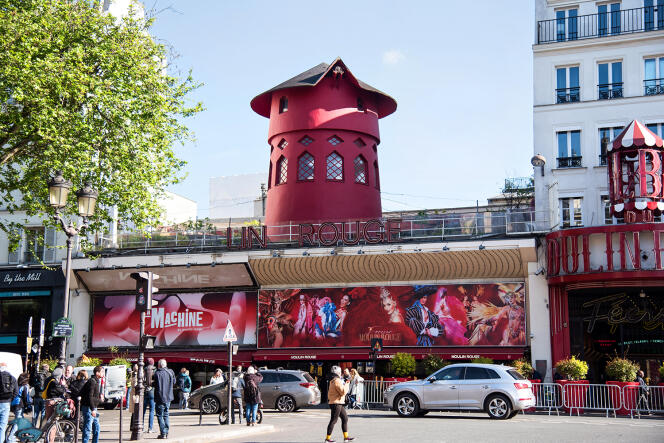


At 2 am on April 25, Paris lost just a smidgen of its splendor. The blades from the Moulin Rouge, which has been lighting up Parisian nights for 135 years, crashed to the sidewalk in Pigalle, like your typical late-night drunks after a bar fight. Except for the City of Light's bruised ego, there were no injuries from the accident, despite the busy time of night in the district. The blades took with them the M, O and U from the façade, which temporarily featured a ridiculous-looking "LIN ROUGE" that made no sense. The international press was amused − gleeful might be the best way to put it − by this unusual incident. Management quickly reopened the cabaret, which welcomes some 600,000 spectators each year. It promised that the legendary venue would soon regain its lost appendages. But in the end, it was just one more anecdote, one more cancan, from a rich history of drama.
The cabaret was founded in 1889 by Joseph Oller and Charles Zidler. Its architecture drew inspiration from the windmills that once dotted the Montmartre hillside. The decor was a blend of the Japanese style then in vogue and curiosities, such as a giant stucco elephant statue, which later disappeared. Success came quickly. The place attracted both bohemians and aristocrats, who came ready to carouse, drinking, laughing and indulging the night away. Joseph Pujol, known as "le Pétomane," delighted audiences with his flatulence concerts. The comic duo Foottit and Chocolat − the latter a Black clown acting as the victim of the former − were a triumph. There was also a form of dance called "the French cancan," which originated in England. The spectacle of petticoats and legs in the air, with garters in full view, immediately drew the crowds.
Among the dancers at the Moulin Rouge, Louise Weber earned herself the nickname of "la Goulue," owing to her propensity for draining customers' glasses. She also made a specialty of kicking off gentlemen's top hats with her foot. A regular at the cabaret, Henri Toulouse-Lautrec painted the dancer in his posters and paintings, at the same time forever capturing the atmosphere at the Moulin Rouge. Dancers such as "Môme Fromage," "Grille d'égout," "Jane la Folle," "Nini Patte-en-l'air" and "Rayon d'or" also made their mark. Singer Yvette Guilbert made a name for herself there. The contortionist "Valentin le Désossé" showed off his flexibility. In 1893, an all-nude Cleopatra act caused a delightful scandal. Operetta soon reigned supreme, and the French performer Mistinguett triumphed. In 1915, the cabaret burned to the ground and then rose from the ashes, having expanded in size.
In the 1930s, the music hall went through a slump before getting a second wind. The shows that followed for decades were headlined by big names, from Line Renaud to Liza Minnelli, and Zizi Jeanmaire to Mikhail Baryshnikov. Edith Piaf met Yves Montand here at the time of the liberation. Luis Mariano, Charles Trenet, Charles Aznavour, Bourvil, Maurice Chevalier, Josephine Baker, Bing Crosby, Ginger Rogers, Dalida and the Village People all performed here, between a trapeze act and the unavoidable French cancan. Elvis Presley, Frank Sinatra and Elton John also made appearances, even Queen Elizabeth II was a fan. But the unbridled atmosphere of the early days, as depicted in Baz Luhrmann's 2001 film Moulin Rouge, starring Nicole Kidman, had faded. The famous cabaret gradually became a must-see for tourists, with its dinner shows now priced at €225 per person, including champagne.
Translation of an original article published in French on lemonde.fr; the publisher may only be liable for the French version.
